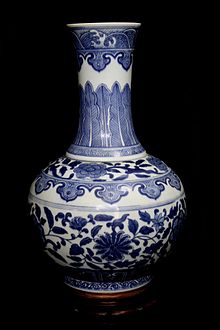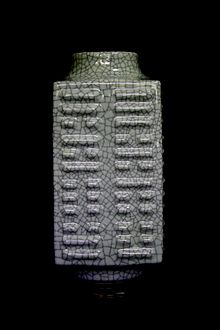- Chinese Tongzhi ceramics
-
Chinese Tongzhi 同治 (1862–1874) porcelain marks the reconstruction of the Jingdezhen 景德鎮 official kilns after the destructive Taiping Rebellion 太平天国 which completely devastated the area. Already by 1853 Nanking had fallen and was made the capital by the rebel forces. Eventually Zeng Guofan 曾國藩 of the Imperial Ching forces defeated the rebels and restored imperial Ching rule. The period was one of continued unrest. In 1856 the English had attacked Guangtong. They invaded the capital itself, looting and burning the celebrated Yuanming Palace 圆明园. It was against this background of these events, and others, that the Tongzhi Emperor took to the throne and palace functions were partially restored. The official palace ceramic wares of this period are thought to reflect this general historical unrest and decline. The Jingdezhen area itself was liberated by the well known Li Hongzhang 李鴻章 in 1864.
The new Imperial kilns were to be under the directorship of the official Cai Jinching. After completion a list of ceramic wares was forwarded to the Emperor and is preserved in the area gazetteer Jiangxi tongzhi 江西通志. The wares consisted of round wares (yuanqi) and vases (zhuoqi). It is difficult to imagine the ceramics of this period would be dramatically different from those of the previous Daoguang 道光 (1821–1850) period. Indeed many of the artisans of the early 19th century must have continued in their profession with the restorations of the kilns.
Two ceramic artists associated with later productions of Qianjiang ware or porcelain decorated in sepia and pale umber pigments, Wang Shaowei and Jin Pinqing, are said to have been employed in the Tongzhi era as decorators at Jingdezhen. Certainly there was a quantitative disparity. The extant list of Tongzhi ceramics include such items as quadrangular vases with the Eight Triagrams 八卦 and other items. Extant under glaze blue vases are renditions of classic shapes and patterns continuously celebrated from the 18th century.
References
- Sugimura Yuzo, Shin no Kanyo (Ching Dynasty Imperial Kilns), Tokidaikei 46, Heibonsha Press, Tokyo, 1973.
- Soame Jenyns, Later Chinese Porcelain, Faber and faber, London, 1951.
Categories:- Chinese porcelain
Wikimedia Foundation. 2010.


